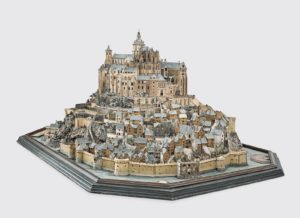 Lasting roughly 15 minutes, which is not long but not short either, the device overlays holographic images on top of the 3D model, with audio detailing the history of the object and the site itself. At one point, the device overlays the entire gallery space with a holographic copy of the abbey of the church, digitally transporting you into the architectural space. The experience overall is enjoyable and informative.
Lasting roughly 15 minutes, which is not long but not short either, the device overlays holographic images on top of the 3D model, with audio detailing the history of the object and the site itself. At one point, the device overlays the entire gallery space with a holographic copy of the abbey of the church, digitally transporting you into the architectural space. The experience overall is enjoyable and informative.
This visualization of Mont-Saint-Michel is interesting as a hint of how AR might enter into traditional museum outreach and education initiatives in the future. But it is only a hint—and the leading edge will be using the technology not just for education, but also “for good.”
Recently, the Knight Foundation awarded five art institutions $750,000 to share in the creation of “experimental projects that explore new ways to engage audiences through immersive experiences.” Knight partnered with Microsoft to allow these institutions to access its AI technology and receive coaching from AR/VR experts. The five organizations are the American Museum of Natural History, New York; the Museum of the Moving Image, Queens, New York; the Museum of Art and Design at Miami Dade College; the Japanese American Museum in San Jose; and the Colored Girls Museum, Philadelphia.
See the full story here: https://news.artnet.com/exhibitions/microsoft-ar-vr-art-museum-1737159